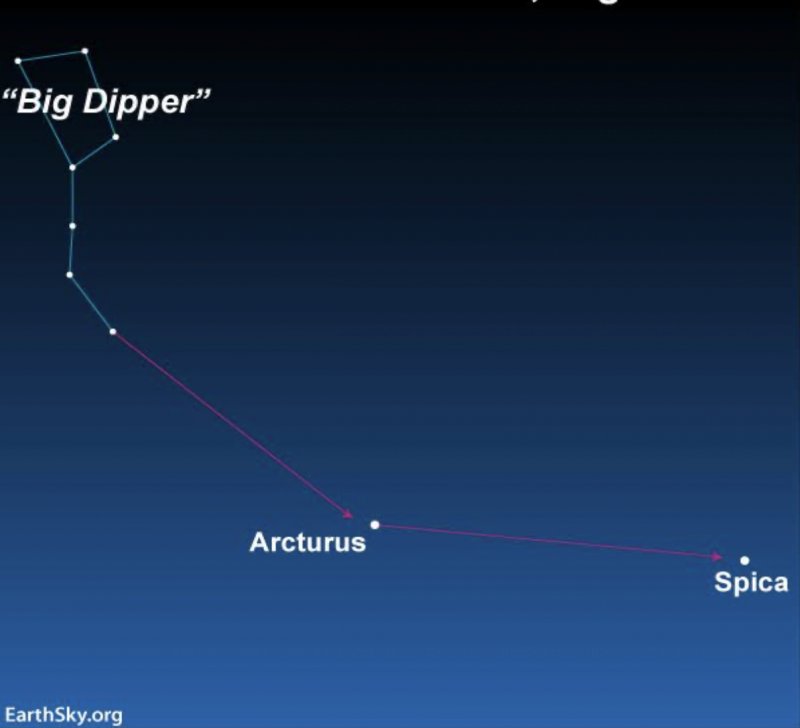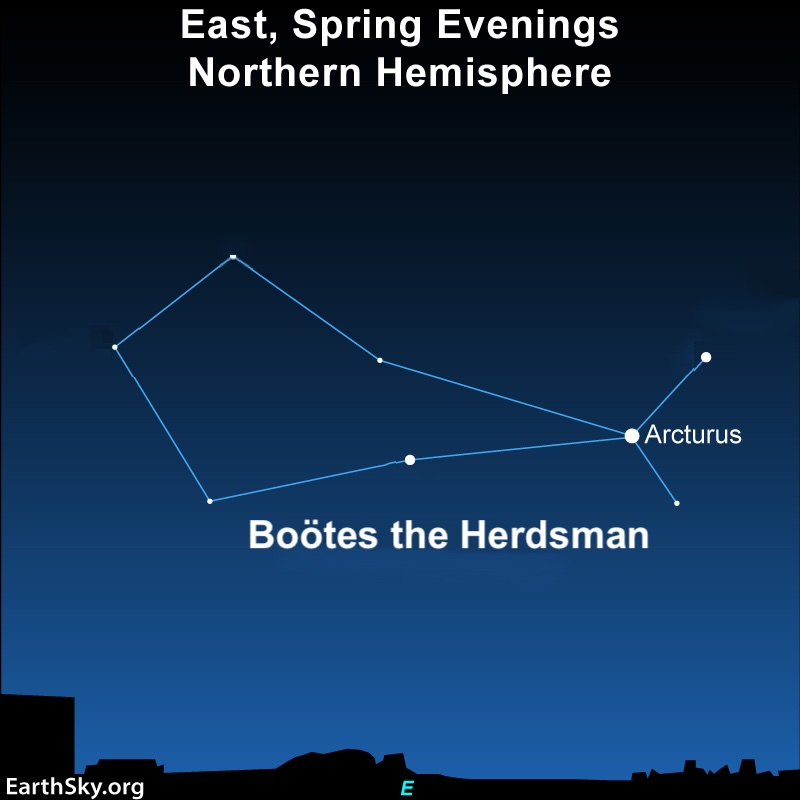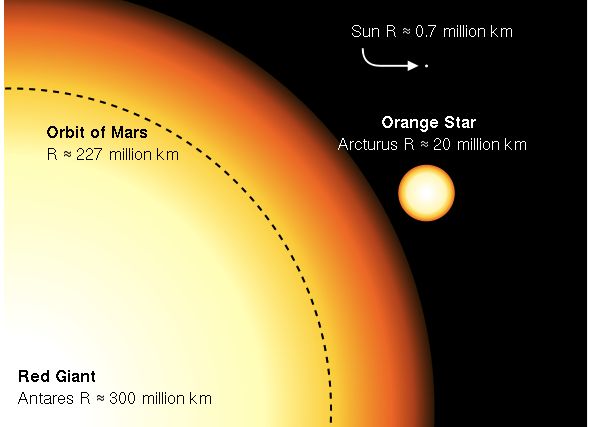
Arcturus is a red giant star located only 36.7 light-years away. It’s the 4th-brightest star in the sky and the brightest one in the northern half of the sky. Look for it on spring evenings in the Northern Hemisphere by arcing to Arcturus from the Big Dipper‘s handle.
Arcturus is the alpha star of a cone-shaped constellation called Boötes the Herdsman. It’s far enough north on the sky’s dome that – for Northern Hemisphere observers – it’s visible during some part of the night throughout most of the year. There’s an easy mnemonic for identifying this brilliant orange star. Just remember the phrase follow the arc to Arcturus and then speed on to Spica.
First, locate the Big Dipper in the northern sky. Notice that the handle of the Big Dipper is a curve or arc. Extend this curve past the end of the Big Dipper’s handle, and you’ll reach Arcturus.
A lonely bright star
You might notice sparkling orange Arcturus passing high overhead on late spring evenings. In summer, Arcturus is high in the sky shortly after dark. Autumn observers need to look early because it sets by mid-evening. In winter, the best time to observe it is in the wee hours before dawn.
Unlike most of the bright stars in the nighttime sky, Arcturus has no bright neighbors. It commands the sky in the springtime and reigns the heavens until the Summer Triangle takes over the eastern sky.
Our chart below shows the constellation Boötes as you stand facing east on spring evenings. Seeing a Herdsman in these stars might be difficult, but the constellation is easy to imagine as a kite.

Arcturus is the brightest star north of the celestial equator
What does that mean? Imagine that Earth’s equator projected onto the sky. This line above Earth’s equator is the celestial equator. It divides the sky into northern and southern hemispheres, just as Earth’s equator does for Earth. The three brightest stars of the sky – Sirius, Canopus and Alpha Centauri – are south of the celestial equator.
Meanwhile, Arcturus is the brightest star in the northern part of the sky. It is only marginally brighter than the Northern Hemisphere’s second-brightest star, Vega. Some people believe that Polaris, the North Star, is the brightest star in the sky because it is famous. But it’s quite faint, only about the 50th brightest star.
Visible during daytime
In 1635, less than three decades after the invention of the telescope, Jean-Baptiste Morin of France observed Arcturus in the daytime with the telescope. This was the first time that any star, besides the sun and a rare supernova, had been seen telescopically during daylight hours. You can go one step further and observe Arcturus with the unaided eye during the daytime. Here is an account from 1911 of how you can do this.
History and mythology of Arcturus
Arcturus’ constellation Boötes the Herdsman is sometimes pictured as guarding the Great Bear, or Ursa Major, which contains the Big Dipper asterism. We sometimes hear Arcturus called the Bear Guard.
In China, Arcturus’ constellation is also called the Dragon. In some classical Greek stories, Boötes was Icarus, who flew too close to the sun. Passing directly over the Hawaiian islands, Arcturus was a particularly important navigational star to the islands’ indigenous inhabitants and other Polynesians.
The translation may be questioned, but Arcturus is among the few stars mentioned in the Bible. (“Which maketh Arcturus, Orion and Pleiades, and the chambers of the south” – Job 9:9, KJV, and “Canst thou bring forth Mazzaroth in his season? or canst thou guide Arcturus with his sons?” – Job 38:32, KJV.)
1933 Century of Progress Exposition in Chicago
One interesting story about Arcturus relates to the 1933 Century of Progress Exposition in Chicago. Its promoters wanted a flashy way to open the show, so they decided to have the light from Arcturus start the show. At 9:15 pm on May 27, 1933, four telescopes located in different observatories captured the light from Arcturus and focused it into photoelectric cells. The photocells in turn worked as the switch that turned on the main spotlights to open the exhibition. It’s a good thing it wasn’t cloudy!
There had also been a World’s Fair in Chicago in 1893, 40 years before the 1933 show. At the time, astronomers thought that Arcturus was 40 light-years away. If so, that light left Arcturus at the end of the 1893 fair and traveled for 40 years through space like an Olympic torch bearer, to open the 1933 show.
The promoters of Chicago’s World’s Fair had a great idea, but today’s astronomers place the distance to Arcturus at just less than 37 light-years. Maybe it should have been used for the groundbreaking ceremony!

Arcturus is large and old
Arcturus is most likely considerably older than our sun. When the sun evolves to become a red giant, it will be a star much like Arcturus is now.
Arcturus’ diameter is roughly 25 times greater than our sun. Because of its larger size, Arcturus radiates more than 100 times the light of our sun, in visible light. If you consider infrared and other frequencies in the electromagnetic spectrum, Arcturus is about 200 times more powerful than the sun. Its mass is slightly greater than that of our sun.
The reddish or orange color of Arcturus signifies its temperature, which is about 7,300 degrees Fahrenheit (around 4,000 degrees Celsius). That makes it several thousand degrees cooler than the surface of the sun.
Flying south to the winter sky
The bright orange star Arcturus is especially noteworthy for its large proper motion, or sideways motion, on the dome of Earth’s sky. Only Alpha Centauri – our sun’s nearest neighbor among the stars – has a higher proper motion among the 1st-magnitude, or bright, stars in our stellar neighborhood. And of course, the large proper motion of Alpha Centauri stems from the fact that it’s so close to us.
In the meantime, what does the proper motion of Arcturus tell us?
It tells us that Arcturus is moving at a tremendous speed (122 km/s or 76 miles/s) relative to our solar system. Arcturus is thought to be an old star. It appears to be moving with a group of at least 52 other such stars, known as the Arcturus stream or Arcturus moving group. Scientists believe these stars were not originally part of the Milky Way but came from a dwarf satellite galaxy whose stars have now become assimilated into the Milky Way.
Gone in 150,000 years!
From the vantage point of Earth, Arcturus is rapidly moving in a southerly direction at a rate of 3.9 arcminutes per century. It’s now at about its closest point to Earth. As it moves away it will vanish from visibility to the unaided eye when it reaches the Carina-Vela border in about 150,000 years.
Enjoying EarthSky so far? Sign up for our free daily newsletter today!
The position of Arcturus is RA: 14h 15 m 39.7s, dec: +19° 10′ 56″

Bottom line: The 4th-brightest star in all the sky is Arcturus, a brilliant orangish star that’s easy to find in Northern Hemisphere spring skies with the aid of the Big Dipper.
The post Arcturus, the brightest star of the northern sky first appeared on EarthSky.
from EarthSky https://ift.tt/padMJuc

Arcturus is a red giant star located only 36.7 light-years away. It’s the 4th-brightest star in the sky and the brightest one in the northern half of the sky. Look for it on spring evenings in the Northern Hemisphere by arcing to Arcturus from the Big Dipper‘s handle.
Arcturus is the alpha star of a cone-shaped constellation called Boötes the Herdsman. It’s far enough north on the sky’s dome that – for Northern Hemisphere observers – it’s visible during some part of the night throughout most of the year. There’s an easy mnemonic for identifying this brilliant orange star. Just remember the phrase follow the arc to Arcturus and then speed on to Spica.
First, locate the Big Dipper in the northern sky. Notice that the handle of the Big Dipper is a curve or arc. Extend this curve past the end of the Big Dipper’s handle, and you’ll reach Arcturus.
A lonely bright star
You might notice sparkling orange Arcturus passing high overhead on late spring evenings. In summer, Arcturus is high in the sky shortly after dark. Autumn observers need to look early because it sets by mid-evening. In winter, the best time to observe it is in the wee hours before dawn.
Unlike most of the bright stars in the nighttime sky, Arcturus has no bright neighbors. It commands the sky in the springtime and reigns the heavens until the Summer Triangle takes over the eastern sky.
Our chart below shows the constellation Boötes as you stand facing east on spring evenings. Seeing a Herdsman in these stars might be difficult, but the constellation is easy to imagine as a kite.

Arcturus is the brightest star north of the celestial equator
What does that mean? Imagine that Earth’s equator projected onto the sky. This line above Earth’s equator is the celestial equator. It divides the sky into northern and southern hemispheres, just as Earth’s equator does for Earth. The three brightest stars of the sky – Sirius, Canopus and Alpha Centauri – are south of the celestial equator.
Meanwhile, Arcturus is the brightest star in the northern part of the sky. It is only marginally brighter than the Northern Hemisphere’s second-brightest star, Vega. Some people believe that Polaris, the North Star, is the brightest star in the sky because it is famous. But it’s quite faint, only about the 50th brightest star.
Visible during daytime
In 1635, less than three decades after the invention of the telescope, Jean-Baptiste Morin of France observed Arcturus in the daytime with the telescope. This was the first time that any star, besides the sun and a rare supernova, had been seen telescopically during daylight hours. You can go one step further and observe Arcturus with the unaided eye during the daytime. Here is an account from 1911 of how you can do this.
History and mythology of Arcturus
Arcturus’ constellation Boötes the Herdsman is sometimes pictured as guarding the Great Bear, or Ursa Major, which contains the Big Dipper asterism. We sometimes hear Arcturus called the Bear Guard.
In China, Arcturus’ constellation is also called the Dragon. In some classical Greek stories, Boötes was Icarus, who flew too close to the sun. Passing directly over the Hawaiian islands, Arcturus was a particularly important navigational star to the islands’ indigenous inhabitants and other Polynesians.
The translation may be questioned, but Arcturus is among the few stars mentioned in the Bible. (“Which maketh Arcturus, Orion and Pleiades, and the chambers of the south” – Job 9:9, KJV, and “Canst thou bring forth Mazzaroth in his season? or canst thou guide Arcturus with his sons?” – Job 38:32, KJV.)
1933 Century of Progress Exposition in Chicago
One interesting story about Arcturus relates to the 1933 Century of Progress Exposition in Chicago. Its promoters wanted a flashy way to open the show, so they decided to have the light from Arcturus start the show. At 9:15 pm on May 27, 1933, four telescopes located in different observatories captured the light from Arcturus and focused it into photoelectric cells. The photocells in turn worked as the switch that turned on the main spotlights to open the exhibition. It’s a good thing it wasn’t cloudy!
There had also been a World’s Fair in Chicago in 1893, 40 years before the 1933 show. At the time, astronomers thought that Arcturus was 40 light-years away. If so, that light left Arcturus at the end of the 1893 fair and traveled for 40 years through space like an Olympic torch bearer, to open the 1933 show.
The promoters of Chicago’s World’s Fair had a great idea, but today’s astronomers place the distance to Arcturus at just less than 37 light-years. Maybe it should have been used for the groundbreaking ceremony!

Arcturus is large and old
Arcturus is most likely considerably older than our sun. When the sun evolves to become a red giant, it will be a star much like Arcturus is now.
Arcturus’ diameter is roughly 25 times greater than our sun. Because of its larger size, Arcturus radiates more than 100 times the light of our sun, in visible light. If you consider infrared and other frequencies in the electromagnetic spectrum, Arcturus is about 200 times more powerful than the sun. Its mass is slightly greater than that of our sun.
The reddish or orange color of Arcturus signifies its temperature, which is about 7,300 degrees Fahrenheit (around 4,000 degrees Celsius). That makes it several thousand degrees cooler than the surface of the sun.
Flying south to the winter sky
The bright orange star Arcturus is especially noteworthy for its large proper motion, or sideways motion, on the dome of Earth’s sky. Only Alpha Centauri – our sun’s nearest neighbor among the stars – has a higher proper motion among the 1st-magnitude, or bright, stars in our stellar neighborhood. And of course, the large proper motion of Alpha Centauri stems from the fact that it’s so close to us.
In the meantime, what does the proper motion of Arcturus tell us?
It tells us that Arcturus is moving at a tremendous speed (122 km/s or 76 miles/s) relative to our solar system. Arcturus is thought to be an old star. It appears to be moving with a group of at least 52 other such stars, known as the Arcturus stream or Arcturus moving group. Scientists believe these stars were not originally part of the Milky Way but came from a dwarf satellite galaxy whose stars have now become assimilated into the Milky Way.
Gone in 150,000 years!
From the vantage point of Earth, Arcturus is rapidly moving in a southerly direction at a rate of 3.9 arcminutes per century. It’s now at about its closest point to Earth. As it moves away it will vanish from visibility to the unaided eye when it reaches the Carina-Vela border in about 150,000 years.
Enjoying EarthSky so far? Sign up for our free daily newsletter today!
The position of Arcturus is RA: 14h 15 m 39.7s, dec: +19° 10′ 56″

Bottom line: The 4th-brightest star in all the sky is Arcturus, a brilliant orangish star that’s easy to find in Northern Hemisphere spring skies with the aid of the Big Dipper.
The post Arcturus, the brightest star of the northern sky first appeared on EarthSky.
from EarthSky https://ift.tt/padMJuc

Aucun commentaire:
Enregistrer un commentaire